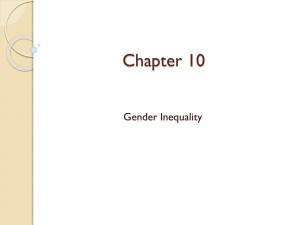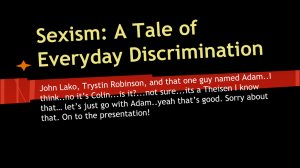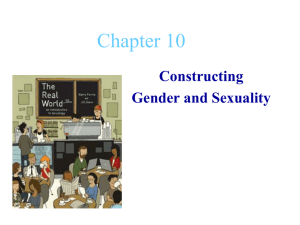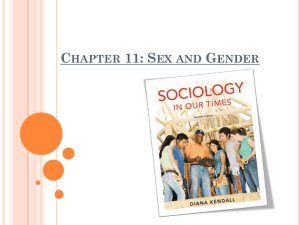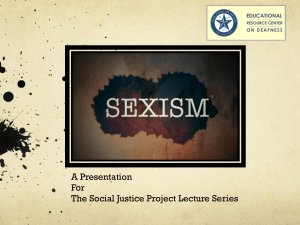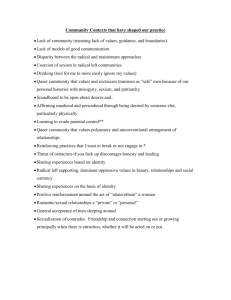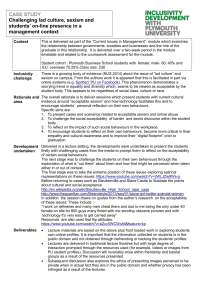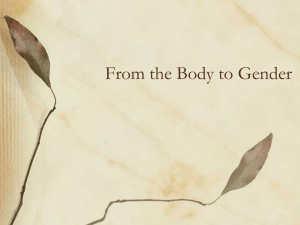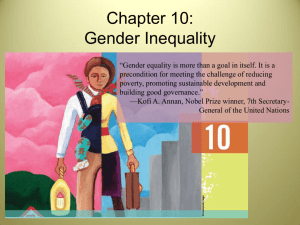SJSUSoc80SocialProblemsChapter_10
advertisement
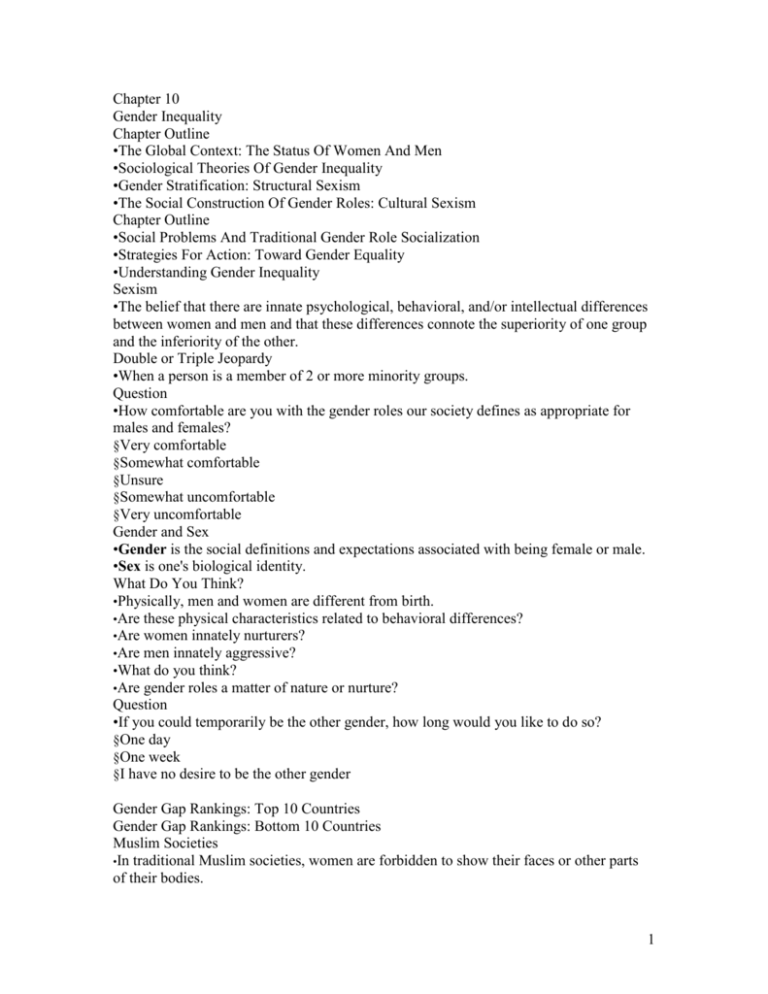
Chapter 10 Gender Inequality Chapter Outline •The Global Context: The Status Of Women And Men •Sociological Theories Of Gender Inequality •Gender Stratification: Structural Sexism •The Social Construction Of Gender Roles: Cultural Sexism Chapter Outline •Social Problems And Traditional Gender Role Socialization •Strategies For Action: Toward Gender Equality •Understanding Gender Inequality Sexism •The belief that there are innate psychological, behavioral, and/or intellectual differences between women and men and that these differences connote the superiority of one group and the inferiority of the other. Double or Triple Jeopardy •When a person is a member of 2 or more minority groups. Question •How comfortable are you with the gender roles our society defines as appropriate for males and females? §Very comfortable §Somewhat comfortable §Unsure §Somewhat uncomfortable §Very uncomfortable Gender and Sex •Gender is the social definitions and expectations associated with being female or male. •Sex is one's biological identity. What Do You Think? •Physically, men and women are different from birth. •Are these physical characteristics related to behavioral differences? •Are women innately nurturers? •Are men innately aggressive? •What do you think? •Are gender roles a matter of nature or nurture? Question •If you could temporarily be the other gender, how long would you like to do so? §One day §One week §I have no desire to be the other gender Gender Gap Rankings: Top 10 Countries Gender Gap Rankings: Bottom 10 Countries Muslim Societies •In traditional Muslim societies, women are forbidden to show their faces or other parts of their bodies. 1 •Some women adhere to this out of fear, others believe veiling was first imposed out of respect for women and the desire to protect them. Structural Functionalist Perspective •Pre-industrial society required a division of labor based on gender. •Women nursed and cared for children. •Men were responsible for material needs. •Industrialization made traditional division of labor less functional, belief system remains. Conflict Perspective •Continued domination by males requires a belief system that supports gender inequality. •Two beliefs: •Women are inferior outside the home. •Women are more valuable in the home. Symbolic Interactionist Perspective •Gender and gender roles are learned through socialization process. •Women are socialized into expressive roles. •Men are socialized into instrumental roles. Question •Symbolic interactionists emphasize that through the socialization process both females and males are taught the meanings associated with being feminine and masculine. §True §False Answer: A. True •Symbolic interactionists emphasize that through the socialization process both females and males are taught the meanings associated with being feminine and masculine. Advertising and Sexism •This billboard is a good example of the cultural emphasis placed on women’s physical appearance. Traditional Roles •Expressive roles •Roles into which women are traditionally socialized, i.e., nurturing and emotionally supportive roles. •Instrumental roles •Roles into which men are traditionally socialized, i.e., task-oriented roles. Structural Sexism •The ways in which the organization of society, and specifically its institutions, subordinate individuals and groups based on their sex classification. Education and Structural Sexism •Worldwide, women are less likely than men to be literate. •In U.S. men are more likely to have doctorate degrees. •Women are socialized to choose marriage and motherhood over career preparation. Science and Engineering Doctorates Awarded to Women, 2005 Work and Structural Sexism •According to the International Labor Office (ILO), in 2006, women made up 40% of the world’s total labor force. 2 •Worldwide, women tend to work in jobs that have little prestige and low or no pay, where no product is produced, and where they are the facilitators for others. •Women are more likely to hold positions of little or no authority and to have more frequent and longer periods of unemployment. Highly Sex-Segregated Occupations 2003 Highly Sex-Segregated Occupations 2003 Highly Sex-Segregated Occupations 2003 Highly Sex-Segregated Occupations 2003 Highly Sex-Segregated Occupations 2003 Highly Sex-Segregated Occupations 2003 What Do You Think? •A report by the British Equal Opportunities Commission found that as in the U.S., men in the United Kingdom tend to work in plumbing, construction and engineering, while 3/4 of women work in cleaning, catering, caring, cashiering, and clerical. •Did a high school or college advisor direct you into traditional male or female areas of study? •How are your goals influenced by society’s definitions of male and female occupations? Glass Elevator Effect •The tendency for men seeking or working in traditionally female occupations to benefit from their minority status. Pink-collar Job •Jobs that offer few benefits, often have low prestige, and are disproportionately held by women. Glass Ceiling •An invisible barrier that prevents women and other minorities from moving into top corporate positions. Structured Choice •Choices that are limited by the structure of society. Income and Structural Sexism •Women are twice as likely as men to earn at or below minimum wage. •In 2005, full-time working women had median weekly earnings of $612, compared with full-time weekly earnings of $771 for men. •The U.S. gender gap in pay has decreased over the years, from women making 60% of what a man made in 1980 to nearly 80% of what a man makes today. Ratio of Women’s to Men’s Earnings Across the U.S., 2005 Effects of Education and Sex on Weekly Earnings of Full-Time Workers, 2005 Effects of Education and Sex on Weekly Earnings of Full-Time Workers, 2005 Gender Gap Hypotheses •Devaluation hypothesis •Argues women are paid less because the work they do is socially defined as less valuable than the work performed by men. •Human capital hypothesis •Argues that female-male pay differences result from differences in women's and men's education, skills, training, and work experience. Emotion Work 3 •Work that involves caring for, negotiating, and empathizing with people. Comparable Worth •The belief that individuals in occupations, even in different occupations, should be paid equally if the job requires “comparable” levels of education, training, and responsibility. •In a comparable worth lawsuit, nurses successfully sued the City of Denver for paying them less than other employees (e.g., tree trimmers, sign painters) who had less education. % of Women Elected by Level of Government Position, 2005 % of Women Elected by Level of Government Position, 2005 Question •Do you agree or disagree with this statement: Most men are better suited emotionally for politics than are most women. –Agree –Disagree Cultural Sexism •The ways in which the culture of society (norms, values, beliefs, symbols) perpetuates subordination based on sex classification. What Do You Think? •These arguments justify treating men and women differently: •Married women work to pay for “extras,” men work to support their families. •Women will get pregnant and quit so there is no need to invest in their training. •Is preferential treatment in the workplace ever justified? The Second Shift •According to Hochschild, women are expected to work “second shifts” by having gainful outside employment as well as performing household chores and child care once they arrive home after a day’s work. Explanations for a Continued Traditional Division of Labor §Time-availability approach –Claims role performance is a function of who has the time to accomplish certain tasks. §Relative resources approach –The spouse with the least power is relegated the most unrewarding tasks. Explanations for a Continued Traditional Division of Labor §Gender role ideology –The division of labor is a consequence of traditional socialization and accompanying attitudes and beliefs. Question •Steve and Linda are married. Both work full time outside the home. Steve works as a lawyer, Linda as a schoolteacher. Linda does most of the household work. Using this example, which of these ideas explains the continued traditional division of labor? §"relative resources approach" §"time-availability approach" §all of these choices §"gender role ideology" Answer: C •Steve and Linda are married. Both work full time outside the home. Steve works as a lawyer, Linda as a schoolteacher. Linda does most of the household work. Using this 4 example, all three of these ideas explain the continued traditional division of labor: relative resources approach, time-availability approach, and gender role ideology. The School Experience and Cultural Sexism •1990 study of storybooks used in schools found: •Males were depicted as clever, brave, adventurous, and income-producing. •Females were depicted as passive and as victims in need of rescue. Kid’s Careers Website •As this picture from the U.S. Bureau of Labor Statistics’ Kid’s Careers website illustrates, males are less likely to be encouraged to choose gender-atypical areas of study. Religion and Gender •Roman Catholic women with the sacraments of communion as part of their ordination as “women priests” in conflict with Roman Catholic Church doctrine. •Faced with excommunication, women participated in five such ordinations around the world since 2002. Religion and Cultural Sexism •In 1998 the Southern Baptist Convention took the stance that a wife should “submit graciously” to her husband, assume her “God-given responsibility to respect her husband, and [to] serve as his helper.” •Former president Jimmy Carter, a lifelong, active Southern Baptist, left the church in protest over this statement. Religion and Cultural Sexism •Orthodox Jewish women are not counted as part of the quorum, required at prayer services, are not allowed to read from the Torah, and are required to sit separately from men at religious services. •Women cannot serve as ordained religious leaders in the Catholic Church, in Orthodox Jewish synagogues, or in Islamic temples. What Do You Think? •A transgender individual is a person whose sense of gender identity is inconsistent with his or her biological sex. •Transsexuals have changed or are in the process of changing their physical sex to conform to their gender identity. •Do you think transgender individuals, including transsexuals, should have the same legal protection as non-transgender individuals? Gender Tourism •The recent tendency for definitions of masculinity and femininity to become less clear, resulting in individual exploration of the gender continuum. The Feminization of Poverty •Many female households are young women with children and women who have outlived their spouses. •“Report card” released by U.S. Women Connect gave U.S. an “F” for efforts to reduce female poverty. Feminization of Poverty •Called the “feminization of poverty,” the tendency for women to be disproportionately poor is evidenced in developing nations where suitable housing, clean water, food, health care, and sanitary living conditions are scarce. 5 Boy Code •A set of societal expectations that discourage males from expressing emotion, weakness, or vulnerability, or asking for help. Men’s Movement •In general, most men’s movements support the goals of seeking improvement in marital relationships, supporting feminism and gender equality, improving interaction with other males, and engaging in more quality interaction with their children. Sexual Harassment •In reference to workplace harassment, when an employer requires sexual favors in exchange for a promotion, salary increase, or any other employee benefit and/or the existence of a hostile environment that unreasonably interferes with job performance. What Do You Think? •Among the findings of a recently released report from the American Association of University Women: •2/3 thirds of undergraduates report having been the victim of sexual harassment. •Females were more likely to say they were upset, ashamed, embarrassed, or humiliated as a result of the harassment than males. •What would you do to reduce the incidents of sexual harassment on your campus? Affirmative Action •A broad range of policies and practices to promote equal opportunity as well as diversity in the workplace and on campuses. Men’s Discriminatory Attitudes Toward Women by Region of the World Sports and Gender Roles •Fifty years ago, women playing professional basketball would have been unimaginable. •Men’s roles are also changing, as seen in this depiction of a men’s locker room. International Women’s Bill of Rights •Adopted by United Nations in 1979. •Establishes rights for women in education, politics, work, law, and family. •Has not been ratified by required 2/3 vote of the U.S. Senate. •Every industrialized country except Switzerland and the U.S., has ratified the treaty. Quick Quiz 1. George is a Hispanic and a known homosexual. On the job he encounters discrimination because of his membership in two minority groups. This is known as: §intensive discrimination. §polysemia. §double jeopardy. §dual prejudice. Answer: C •George is a Hispanic and a known homosexual. On the job he encounters discrimination because of his membership in two minority groups. This is known as double jeopardy. 2. Which is true about women regarding gender inequality in the U.S.? §Women have lower incomes. §Women earn fewer graduate degrees. §Women hold fewer prestigious jobs. 6 §All of these choices. Answer: D •All of the following statements are true about women regarding gender inequality in the U.S.: •Women have lower incomes. •Women earn fewer graduate degrees. •Women hold fewer prestigious jobs. 3. In hunting and gathering society, men hunted and women gathered. This division of labor based on gender became defined as normal and natural over time. Which sociological perspective views this division as purposeful for the time? §conflict theory §structural functionalism §symbolic interactionism §exchange theory Answer: B •In hunting and gathering society, men hunted and women gathered. This division of labor based on gender became defined as normal and natural over time. The structural functionalism sociological perspective views this division as purposeful for the time. 7
